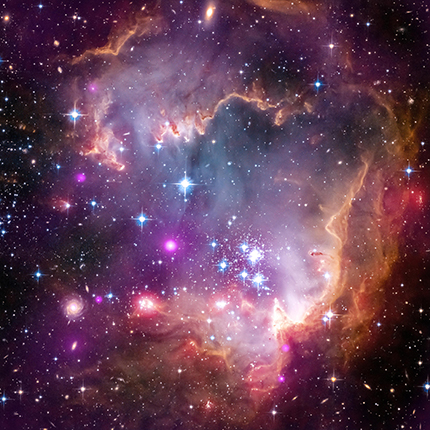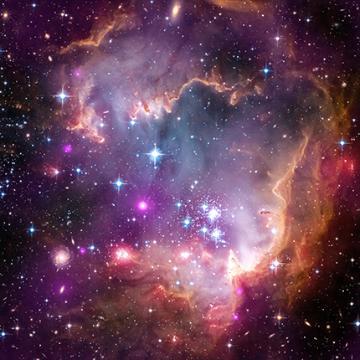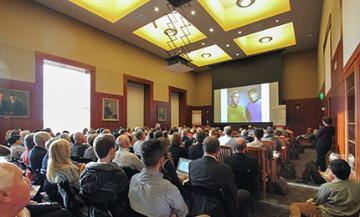
Why Science Needs God
Excerpt from Winter 2014 Bannan Institute Lecture
Once I gave a talk at the College of Charleston, a beautiful campus in Charleston, South Carolina, and after the talk an undergraduate came up full of enthusiasm. “I want to be a geologist!” he told me. I thought that was great; my undergraduate degree is in geology.
“Sounds great,” I told him.
“Yeah, but ...” he said, “What do I tell my mom?”
In the culture where he grew up, studying geology, with our ideas of billion-year-old rock formations, directly contradicted the way he had been taught about the Bible. To be a geologist for him would be like declaring war against his religion, his home, his family. His mom would be ashamed of him.
Scientists are people. We have families; we have desires; like every human being, we are a mixture of reason and heart, with hearts that have “reasons that reason does not know.” And like that student, we have to answer those desires inside us, and those desires inside the other people who are close to us.
There’s a temptation to divide our experience into separate categories—emotions versus logic, faith versus science. But it’s a false division. Real people are not just Kirk, or just Spock. Heck, even Kirk and Spock were not really all Kirk or all Spock. And we have to live with others who themselves are more than Kirk or Spock.
We make all the decisions of our life on the basis of both reason and gut feeling. In the case of the student in South Carolina, it meant choosing between science and religion. But to me, as someone who has lived with both science and religion all my life, that kind of choice was utterly puzzling. What was he thinking? Why would anyone even imagine you had to make such a choice?
Oddly enough, it was Captain Kirk who helped me understand the dilemma.

How I wound up talking to William Shatner—well, it’s a long story, too long to go into here. But when I described myself as a Jesuit scientist, he was flabbergasted. “Wait a minute, wait a minute!” he said. And as we talked, it suddenly became clear to me, something so obvious to him but that I had never grasped before. He saw religion and science as two competing sets of truths. Two big books of facts. And what should happen if the facts in one book contradict the facts in the other?
But science is not a big book of facts. The orbits of the planets are facts; they can be described by Ptolemy’s epicycles; or they can be described by Kepler’s ellipses. Both descriptions can be tweaked to give equally accurate descriptions of those orbits—the facts. But only one of them, Kepler’s, leads to the insight of Newton’s law of gravity. It’s not the facts of the orbits; it is what you do with those facts. And it is also being open to the realization that Newton’s laws, too, are not the last word. Not even Einstein’s general relativity, the modern replacement for Newton, is the last word. I suspect the science of 3014 will look very different from what we’re teaching today.
Likewise, our faith is not based on rigid certainties. I had repeated to William Shatner the phrase that Anne Lamott famously used to describe faith: “the opposite of faith is not doubt; the opposite of faith is certainty.”2 That was completely the opposite of what he thought faith was about. He’d heard the phrase “blind faith” and thought that meant accepting something as certain without looking, or worse, closing your eyes to the facts and proceeding on emotion. But that’s not faith at all. Certainty is the opposite of faith.

Why does any particular person choose to become a scientist? What does being a scientist give you, that no other career can? What constitutes success? Tenure? Grant money? Prizes, honors, and awards? I suspect that what really gets us up in the morning is something more immediate: Joy. I remember once, a few years ago, I had a sabbatical year teaching physics at Fordham. I had a class of really bright students taking the introduction to electricity and magnetism. We’d learned Maxwell’s equations. And I was writing them on the board in front of the class, doing the mathematical manipulations that Maxwell had done back in 1865 on how the equation for electricity gave rise to magnetism and how magnetic fields could give rise to electric fields. You took a derivative here, and put in a substitution there ... and as I wrote down the final equation—the result of all this manipulation, a complicated scrawl of E’s and t’s and Δ’s and μ1’s—before I had a chance to turn around and explain what it all meant, my brightest student in the front row whispered, under his breath but loud enough for everyone to hear him: “Oh my God. It’s a wave.”
Every bit of science we can extract from the glorious pictures from NASA starts with Maxwell’s equations, and the fact that—oh my God, it’s a wave. The fact that it’s a wave gives us radio; electric power transmission of alternating current; and eventually, special and general relativity. Now, it takes a couple of semesters of physics to get
Why does any particular person choose to become a scientist? What does being a scientist give you, that no other career can? What constitutes success? Tenure? Grant money? Prizes, honors, and awards? I suspect that what really gets us up in the morning is something more immediate: Joy.
there; but when you get there, take my word for it—take my student’s word for it—it’s an Oh My God moment.
In my forty years of research, I’ve had a handful of those moments. Nothing as big as Maxwell’s, of course. A couple, big enough to publish in Nature. But it’s not the final paper that I remember; it’s the gasp of amazement when suddenly I saw a pattern in nature that I had not anticipated.
What I am saying is that the meta-reasons underlying science are exactly the pointers that point toward God. The very thing that makes science worth doing, and desirable to do, is the places where we see God. Science needs the “Oh My God” moment. Science needs Oh-My-God. Science wouldn’t happen without it.
Brother Guy Consolmagno, S.J., is a planetary scientist and curator of meteorites at the Vatican Observatory. A native of Detroit, he studied at MIT (S.B. 1974, S.M. 1975) and Arizona (Ph.D. 1978), worked at Harvard and MIT, served in the Peace Corps, and taught university physics before entering the Jesuits in 1989. At the Vatican Observatory since 1993, he studies the physics of meteorites and asteroids and has written several popular books on astronomy and his life as a Jesuit scientist, including: God’s Mechanics: How Scientists and Engineers Make Sense of Religion (2007) and The Heavens Proclaim: Astronomy and the Vatican (2009). He served as chair of the American Astronomical Society’s Division for Planetary Sciences and a past officer of the International Astronomical Union, which named asteroid 4597 Consolmagno in his honor.
Endnotes
- Br. Guy Consolmagno, S.J., “Why Science Needs God,” lecture, 2013–2014 Bannan Institute: What Good Is God? series, February 11, 2014, Santa Clara University. This essay is an excerpt from the lecture; a video of the full lecture is available online at: http://scu.edu/ic/publications/videos.cfm
- Anne Lamott, Plan B: Further Thoughts on Faith (New York: Riverhead Books, 2005).